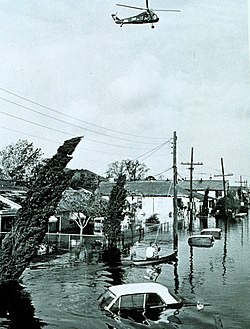Hurricane Betsy
From Wikipedia, the free encyclopedia.
|
Hurricane Betsy track (from NWS) |
|
| Duration | Aug. 27 - Sept. 14, 1965 |
| Highest winds | 155 mph (250 km/h) sustained |
| Damages | $10-12 billion (2005 dollars) |
| Fatalities | 76 direct |
| Areas affected | Windward Islands, Bahamas, south Florida and Florida Keys, Louisiana, inland Southern United States |
| Part of the 1965 Atlantic hurricane season | |
Hurricane Betsy was a powerful storm of the 1965 Atlantic hurricane season which caused enormous damage in the Bahamas, Florida, and Louisiana.
Contents |
Storm history
Betsy formed east of the Windward Islands, and moved north through the island chain as a tropical storm. When it was about 350 miles east of Daytona Beach, Florida, and seemed to be on its way to hit the Carolinas, it turned back toward the southwest, passing over the Bahamas where winds on Great Abaco Island reached 147 mph. Betsy travelled just north of Nassau, the biggest city in the Bahamas, where it stalled for about three hours, allowing its winds to pound the city.
On September 7, Betsy continued moving toward the southwest toward extreme southern Florida. It passed over Key Largo at the eastern end of the Florida Keys, and then continued west along the Keys, as a Category 3 hurricane. Hurricane-force winds were experienced in the Miami area for roughly twelve hours. At its landfall on Key Largo, Betsy had an exceptionally large eye (40 miles in diameter).
After crossing Florida Bay and entering the Gulf of Mexico, Betsy restrengthened, growing into a Category 4 storm with winds up to 155 mph. It continued northwestward, moving into Barataria Bay on the evening of September 9. It made its second U.S. landfall at Grand Isle, Louisiana, just west of the mouth of the Mississippi River, where it destroyed almost every building. At the time of landfall in Louisiana, Betsy was a strong Category 3 storm [1]. The storm travelled upriver, causing the Mississippi at New Orleans to rise by 10 feet.
Impact
Betsy was one of the most intense, deadly, and costly storms to make landfall in the United States. The storm killed 76 people in Louisiana. Betsy caused $1.42 billion in damage, which when adjusted for inflation amounts to $8.5 billion (2000 USD). Betsy was the first hurricane to cause damages in excess of $1 billion; the storm thus earned the nickname "Billion-Dollar Betsy".
Betsy drove storm surge into Lake Pontchartrain, just north of New Orleans, pushing water over levees around the lake and into the city. The Florida Avenue levee was breached, which led to greater flooding in the Ninth Ward of New Orleans and Chalmette. Flood water reached the eaves of houses in some places in the city, and over some 1 story roofs in the Lower 9th Ward, drowning some people in their attics where they had tried to flee the rising waters.
President Lyndon Johnson visited the city, promising New Orleans Mayor Vic Schiro Federal aid.
It was 10 days or more before the water level in New Orleans went down enough for people to return to their homes. It took even longer than that to restore their flooded houses to a livable condition. Those who did not have family or friends with dry homes had to sleep in the shelters at night and forage for supplies during the day, while waiting for the federal government to provide emergency relief in the form of trailers.
In all, 164,000 homes were flooded at the second landfall.
Aftermath
The Army Corps of Engineers' Hurricane Protection Program came into existence as a result of Betsy. The Corps built new levees for New Orleans that were both taller and made of stronger material, designed specifically to resist a fast-moving Category 3 hurricane like Betsy. The resulting levee improvements spared the city from similar flooding in 1969 when Hurricane Camille impacted the area, but failed when Hurricane Katrina, a slow-moving Category 4 hurricane made a near-direct hit on New Orleans on August 29, 2005.
Because of the significance of its damage, the name Betsy was retired from the recurring list of names for hurricanes. It was replaced by Blanche, which was first used in 1969.
Trivia
Unusually, Betsy's track included not one but two complete loops.
Betsy is comparable to 2005's Hurricane Katrina, which followed a similar path but caused more extensive damage and casualties in New Orleans. Numerous other hurricanes, including Hurricane Andrew, the 1947 Fort Lauderdale Hurricane, and the 1926 Miami Hurricane have also followed very similar paths.
External link
- Historic Images of Florida Hurricanes (State Archives of Florida)
- President Lyndon Johnson and the Response to Hurricane Betsy @ University of Virginia's Miller Center of Public Affairs



